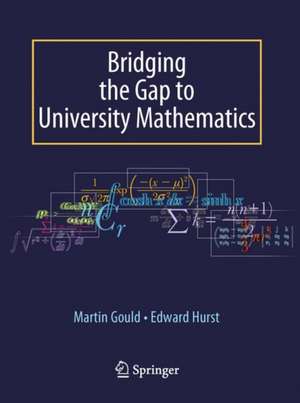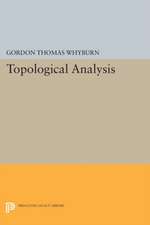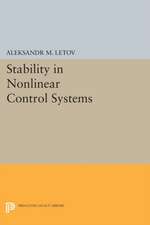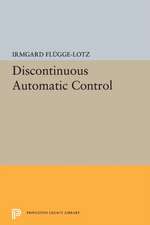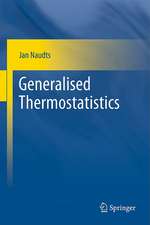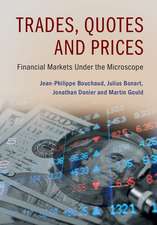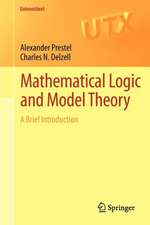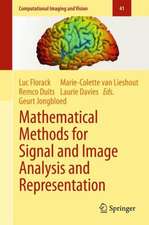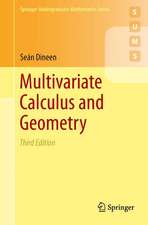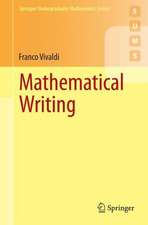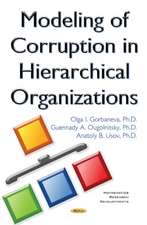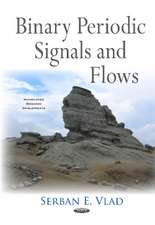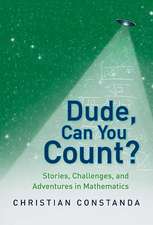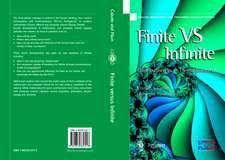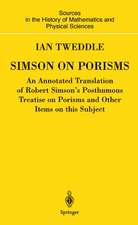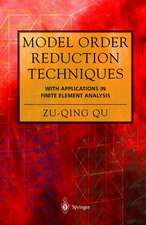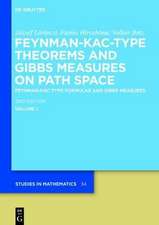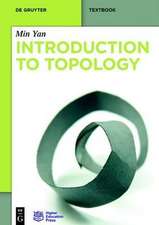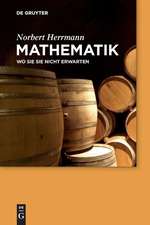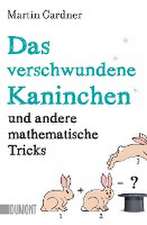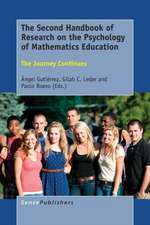Bridging the Gap to University Mathematics
Autor Edward Hurst, Martin Goulden Limba Engleză Paperback – 5 mar 2009
Preț: 122.71 lei
Nou
Puncte Express: 184
Preț estimativ în valută:
23.49€ • 25.52$ • 19.74£
23.49€ • 25.52$ • 19.74£
Carte disponibilă
Livrare economică 31 martie-14 aprilie
Livrare express 14-20 martie pentru 33.71 lei
Preluare comenzi: 021 569.72.76
Specificații
ISBN-13: 9781848002890
ISBN-10: 1848002890
Pagini: 358
Ilustrații: XI, 344 p.
Dimensiuni: 178 x 235 x 16 mm
Greutate: 0.58 kg
Ediția:2009
Editura: SPRINGER LONDON
Colecția Springer
Locul publicării:London, United Kingdom
ISBN-10: 1848002890
Pagini: 358
Ilustrații: XI, 344 p.
Dimensiuni: 178 x 235 x 16 mm
Greutate: 0.58 kg
Ediția:2009
Editura: SPRINGER LONDON
Colecția Springer
Locul publicării:London, United Kingdom
Public țintă
Lower undergraduateCuprins
Inequalities.- Trigonometry, Differentiation and Exponents.- Polar Coordinates.- Complex Numbers.- Vectors.- Matrices.- Matrices as Maps.- Separable Differential Equations.- Integrating Factors.- Mechanics.- Logic, Sets and Functions.- Proof Methods.- Probability.- Distributions.- Making Decisions.- Geometry.- Hyperbolic Trigonometry.- Motion and Curvature.- Sequences.- Series.
Recenzii
From the reviews:
“This book has been ‘written by students for students’. … the quite talkative style makes this book a pleasant ‘arm chair reading’ for freshmen and event teachers. … it can be recommended as an additional source for students in their first year calculus or linear algebra course.” (Jürgen Appell, zbMATH, Vol. 1271, 2013)
“The authors of Bridging the Gap to University Mathematics, were students at a British university. … Their book consists of 20 independent chapters … including two on mechanics and two on differential equations. … Induction is done well, and there is material on logic and truth tables as well as on proof by contrapositive. … the book could be very useful to the beginning mathematics or engineering student–and even to the professor.” (James M. Cargal, UMAP Journal, Vol. 31 (1), 2010)
"The book can be used also by … undergraduate students, graduate students (in their first years), high-school teachers, even mathematics faculty (to get ideas on making their courses more accessible to students). The book covers an array of twenty topics, from simple inequalities to series, and is easy to read, which makes it ideal for self-study. … It is an easy and entertaining read. … a good book to have for any student taking mathematics courses, as well as for any teacher teaching mathematics courses." (Mihaela Poplicher, The Mathematical Association of America, April, 2009)
"Bridging the Gap to University Mathematics is intended to do exactly what the title suggests. Gould and Hurst were, at the time of writing, both students and one gets the feeling that their desire is to tell prospective students what they themselves wish someone had told them before they embarked on their own mathematical journey at university…The book covers a broad range of topics…Well written and easy to read, it divides the material into twenty chapters,which are broken down into manageable chunks. Every chapter begins with ten ’test yourself’ questions designed to help the student discover whether they really do understand a particular topic. As each one is written as a single entity, not depending on preceding content, it is a book that students can dip in and out of rather than read from cover to cover.
It is pleasantly laid out and contains numerous worked examples which clearly illustrate the more complicated concepts. Each subsection is followed by an exercise for the students to work through to test their understanding. All answers, to these and the starter questions, are provided at the back of the book enabling students to monitor their progress. Concluding each chapter is a very helpful section entitled ’where now?’ which explains how this area of mathematics might come into their university course and where it could lead to. Readers are helpfully referred to other texts for further, more in-depth, material or interest. Lastly, an appendix provides useful formulae and extension questions, this time with worked solutions...
The book is written in a fresh, conversational style that is neither patronising nor written in a format intended to solely appeal to the young. It is a book that one could quite easily use as the basis of an introductory or foundation course or to stretch the brightest sixth-formers with something interesting, possibly after they have taken their exams." (Noel-Ann Bradshaw, LMS, September 2010)
“This book has been ‘written by students for students’. … the quite talkative style makes this book a pleasant ‘arm chair reading’ for freshmen and event teachers. … it can be recommended as an additional source for students in their first year calculus or linear algebra course.” (Jürgen Appell, zbMATH, Vol. 1271, 2013)
“The authors of Bridging the Gap to University Mathematics, were students at a British university. … Their book consists of 20 independent chapters … including two on mechanics and two on differential equations. … Induction is done well, and there is material on logic and truth tables as well as on proof by contrapositive. … the book could be very useful to the beginning mathematics or engineering student–and even to the professor.” (James M. Cargal, UMAP Journal, Vol. 31 (1), 2010)
"The book can be used also by … undergraduate students, graduate students (in their first years), high-school teachers, even mathematics faculty (to get ideas on making their courses more accessible to students). The book covers an array of twenty topics, from simple inequalities to series, and is easy to read, which makes it ideal for self-study. … It is an easy and entertaining read. … a good book to have for any student taking mathematics courses, as well as for any teacher teaching mathematics courses." (Mihaela Poplicher, The Mathematical Association of America, April, 2009)
"Bridging the Gap to University Mathematics is intended to do exactly what the title suggests. Gould and Hurst were, at the time of writing, both students and one gets the feeling that their desire is to tell prospective students what they themselves wish someone had told them before they embarked on their own mathematical journey at university…The book covers a broad range of topics…Well written and easy to read, it divides the material into twenty chapters,which are broken down into manageable chunks. Every chapter begins with ten ’test yourself’ questions designed to help the student discover whether they really do understand a particular topic. As each one is written as a single entity, not depending on preceding content, it is a book that students can dip in and out of rather than read from cover to cover.
It is pleasantly laid out and contains numerous worked examples which clearly illustrate the more complicated concepts. Each subsection is followed by an exercise for the students to work through to test their understanding. All answers, to these and the starter questions, are provided at the back of the book enabling students to monitor their progress. Concluding each chapter is a very helpful section entitled ’where now?’ which explains how this area of mathematics might come into their university course and where it could lead to. Readers are helpfully referred to other texts for further, more in-depth, material or interest. Lastly, an appendix provides useful formulae and extension questions, this time with worked solutions...
The book is written in a fresh, conversational style that is neither patronising nor written in a format intended to solely appeal to the young. It is a book that one could quite easily use as the basis of an introductory or foundation course or to stretch the brightest sixth-formers with something interesting, possibly after they have taken their exams." (Noel-Ann Bradshaw, LMS, September 2010)
Textul de pe ultima copertă
- Full-worked solutions to all exercises available at www.springer.com
The book can be used as a source of private study before embarking on a degree or as a textbook for an introductory course. Clear descriptions and a vast assortment of exercises – complete with solutions – enable the reader to develop and then practice new skills. Topics are delivered as twenty self-contained, manageable chapters, allowing students to dip in and out as they require, easily identifying those areas on which they need practice, whilst skimming over more familiar material. Important concepts are introduced in an easy-to-read manner with a sustained emphasis on worked examples and applications rather than abstract theory. Each chapter also includes an insight into where the reader’s new skills will be employed during the course of their studies, providing a springboard to further research where desired.
Caracteristici
Covers a wider area of subjects than any other book aimed at A-Level-to-undergraduate students A “down-to-earth” style makes it more accessible to readers The “Test Yourself” exercise at the beginning of each chapter makes it easier for the reader to find out exactly what material they aren’t familiar with Includes supplementary material: sn.pub/extras
